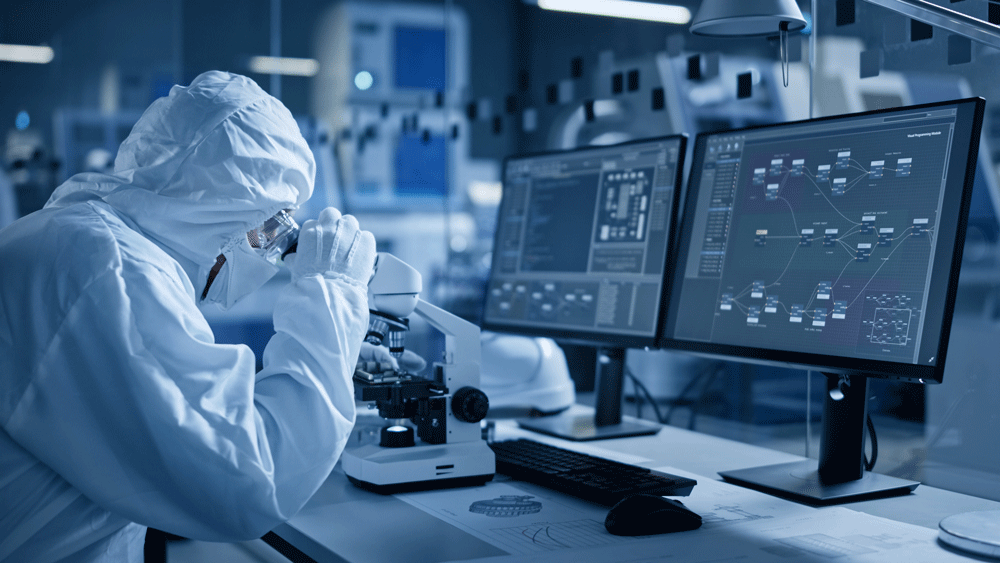Bioprocessing 4.0-4.2 Revolutionizes Production in Asia Pacific
04 April 2023 | Tuesday | News

Image Source : Public Domain
Bioprocessing is a rapidly evolving field, with new technologies and approaches emerging all the time. Bioprocessing 4.0-4.2 refers to the latest trends in the industry, which are transforming the way bioprocessing is carried out. Asia and the Asia Pacific region are at the forefront of these developments, with innovative companies and research institutions leading the way. In this article, we will explore Bioprocessing 4.0-4.2 in Asia and the Asia Pacific, examining the latest trends, challenges, and opportunities.
What is Bioprocessing 4.0-4.2?
Bioprocessing 4.0-4.2 is a new paradigm in bioprocessing that combines cutting-edge technologies such as artificial intelligence, automation, and robotics to optimize the bioprocessing workflow. This approach involves the integration of digital and physical systems to enable real-time monitoring, analysis, and optimization of bioprocessing operations.
The goal of Bioprocessing 4.0-4.2 is to improve efficiency, productivity, and product quality while reducing costs and time-to-market. By leveraging data analytics and machine learning algorithms, bioprocessing operations can be optimized to ensure the highest yields and quality, while minimizing waste and environmental impact.
Trends in Bioprocessing 4.0-4.2 in Asia Pacific
Asia and the Asia Pacific region are home to some of the world's most innovative bioprocessing companies and research institutions. These organizations are leading the way in the adoption of Bioprocessing 4.0-4.2, driving innovation and transforming the industry. Here are some of the key trends in Bioprocessing 4.0-4.2 in Asia and Asia Pacific:
- Automation and Robotics
Automation and robotics are playing an increasingly important role in bioprocessing operations in Asia and Asia Pacific. Companies are investing in automated systems to streamline production, reduce labor costs, and improve consistency and quality. Robotics are being used for tasks such as cell culture, media preparation, and purification, enabling faster, more efficient production.
- Data Analytics and Machine Learning
Data analytics and machine learning are transforming bioprocessing operations in Asia and Asia Pacific. By analyzing data in real-time, companies can optimize production and reduce waste, leading to improved yields and product quality. Machine learning algorithms are being used to predict outcomes and optimize processes, enabling faster, more efficient production.
- Advanced Bioreactor Technologies
Bioreactors are critical components of bioprocessing operations, and new technologies are emerging that are revolutionizing their design and operation. Asia and Asia Pacific are home to innovative companies that are developing advanced bioreactor technologies, such as single-use bioreactors, microfluidic bioreactors, and perfusion bioreactors. These technologies offer improved scalability, flexibility, and efficiency, enabling faster, more cost-effective production.
Here is a table outlining some examples of Bioprocessing 4.0-4.2 progress in Asia by company:
| Country | Company | Example of Bioprocessing 4.0-4.2 Progress |
|---|---|---|
| Japan | Hitachi Chemical | Development of AI-enabled bioreactors for more efficient and precise cell culture in pharmaceutical production |
| China | Sinovac Biotech | Implementation of automation and digitalization in vaccine production, resulting in a 40% increase in output |
| South Korea | CJ CheilJedang | Use of big data and analytics to optimize fermentation processes and reduce production costs in bio-based chemicals |
| Singapore | Merck | Development of single-use bioreactors and sensors for more flexible and efficient biomanufacturing |
| India | Bharat Biotech | Development of a novel adjuvant technology for enhancing the effectiveness of vaccines |
| Taiwan | Advantech | Development of IoT-enabled bioprocessing systems for real-time monitoring and control of bioproduction processes |
| Malaysia | FGV Holdings | Adoption of Industry 4.0 technologies in palm oil processing, including IoT sensors and data analytics, for improved efficiency and sustainability |
| Thailand | PTT Global Chemical | Development of bio-based chemicals and materials using bioprocessing technologies for sustainable production |
Note: This is not an exhaustive list and there may be many other examples of Bioprocessing 4.0-4.2 progress in Asia by company that are not included in this table.
Challenges in Bioprocessing 4.0-4.2 in Asia Pacific
Despite the many opportunities presented by Bioprocessing 4.0-4.2, there are also significant challenges that must be addressed. These challenges include:
- Data Management
The large amounts of data generated by Bioprocessing 4.0-4.2 operations require advanced data management systems to ensure accuracy, security, and accessibility. Companies must invest in robust data management systems to ensure that data can be efficiently analyzed and acted upon.
- Workforce Development
Bioprocessing 4.0-4.2 requires a highly skilled workforce with expertise in automation, robotics, data analytics, and machine learning. Companies must invest in workforce development programs to ensure that their employees have the necessary skills to operate and maintain advanced bioprocessing systems.
- Regulatory Compliance
The use of advanced technologies in bi
processing operations raises new regulatory challenges, particularly in areas such as data privacy and cybersecurity. Companies must ensure that they comply with all relevant regulations and standards, including those related to the collection, storage, and use of data.
Opportunities in Bioprocessing 4.0-4.2 in Asia Pacific
Despite the challenges, there are significant opportunities presented by Bioprocessing 4.0-4.2 in Asia and Asia Pacific. These opportunities include:
- Increased Efficiency and Productivity
Bioprocessing 4.0-4.2 enables faster, more efficient production, reducing costs and time-to-market. By optimizing processes and minimizing waste, companies can achieve higher yields and product quality, enabling them to compete more effectively in the global marketplace.
- Improved Quality Control
By leveraging data analytics and machine learning, companies can monitor and control bioprocessing operations in real-time, ensuring the highest levels of quality and consistency. This is particularly important in industries such as pharmaceuticals, where product quality is critical.
- Greater Innovation
Bioprocessing 4.0-4.2 is enabling greater innovation in the bioprocessing industry, as companies explore new technologies and approaches to production. This is driving the development of new products and therapies, and is helping to address some of the world's most pressing health and environmental challenges.
Conclusion
Bioprocessing 4.0-4.2 is transforming the bioprocessing industry, enabling faster, more efficient production and higher product quality. Asia and the Asia Pacific region are at the forefront of these developments, with innovative companies and research institutions leading the way. While there are significant challenges to be addressed, the opportunities presented by Bioprocessing 4.0-4.2 are enormous, and are helping to drive greater innovation and progress in the bioprocessing industry.
Most Read
- Top 25 Biotech & Biopharma Leaders in Sustainable Innovation, 2025
- China’s Biopharma Dealmaking Surges in H1 2025, Driven by Record Licensing and Oncology Focus
- Chikungunya in China: How a “Forgotten” Arbovirus Found the Perfect Storm
- How Innovation Gaps in Biopharma Raise New Safety Concerns
- Smart Implants and the Future of Musculoskeletal Injury Treatment
- How Ethical Gaps in Psychiatry Could Undermine Biopharma Progress
- The Evolving Landscape of Women’s Health Innovation in the Asia-Pacific
- Using NLP-Driven Decision Support in Emergency Health Assistance
- Taiwan Steps Into the Global Spotlight With a New Cancer Therapy
- The Role of Unique Device Identification (UDI) in Tracing Medical Device Safety
- The Importance of a Patient’s Mental Health During Clinical Trials
Bio Jobs
- The State of Biotech and Life Science Jobs in Asia Pacific – 2025
- Avantor’s New CEO Ligner Aims to Unlock Global Potential and Deliver Shareholder Value
- AstraZeneca Commits $50 Billion to U.S. Expansion by 2030 in Biggest-Ever Global Investment
- Thermo Fisher, SAMRC, and South Africa’s Department of Science and Innovation Launch CATIR to Nurture Next-Gen Scientists
- Cube Biotech Appoints Former Sartorius CEO Dr. Joachim Kreuzburg to Board of Directors
- FDA’s AI Transition Marks a Turning Point in Drug Review: Industry Faces Pressure to Adapt Amid 20% Workforce Cut
- WuXi XDC Completes Mechanical Build of Singapore Bioconjugate Manufacturing Hub
News
Editor Picks











